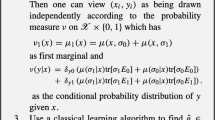Abstract
Here, we develop two quantum-computational schemes for supervised and unsupervised classification tasks in a quantum world by employing the quantum information-geometric tools of quantum fidelity and quantum search algorithm. Presuming that pure states of a set of given quantum systems (or objects) belong to one of two known classes, the objective here is to decide to which of these classes each system belongs—without knowing its state. The supervised binary classification algorithm is based on having a training sample of quantum systems whose class memberships are already known. The unsupervised binary classification algorithm, however, uses a quantum oracle which knows the class membership of the states of the computational basis. Both algorithms require the ability to evaluate the fidelity between states of the quantum systems with unknown states, for which here we also develop a general scheme.


Similar content being viewed by others
References
T. Hastie, R. Tibshirani, J. Friedman, The Elements of Statistical Learning (Springer, New York, 2009)
E. Alpaydin, Introduction to Machine Learning (MIT Press, Cambridge, 2010)
L. Xu, A. Krżyzak, IEEE Trans. Syst. Man. Cybern. 22, 418 (1992)
J.A.K. Suykens, J. Vandewalle, Neural Process. Lett. 9, 293 (1999)
M.A. Nielsen, I.L. Chuang, Quantum Computation and Quantum Information (Cambridge University Press, Cambridge, 2000)
P. Wittek, Quantum Machine Learning - What Quantum Computing Means to Data Mining (Academic Press, Amsterdam, 2014)
M. Schuld, I. Sinayskiy, F. Petruccione, Contemp. Phys. 56, 172 (2015)
J. C. Adcock, E. Allen, M. Day, S. Frick, J. Hinchliff, M. Johnson, S. Morley-Short, S. Pallister, A. B. Price, and S. Stanisic, arXiv:1512.02900
S. Arunachalam, R. de Wolf, ACM SIGACT News 48, 41 (2017)
P. Rebentrost, M. Mohseni, S. Lloyd, Phys. Rev. Lett. 113, 130503 (2014)
A.W. Harrow, A. Hassidim, S. Lloyd, Phys. Rev. Lett. 103, 150502 (2009)
V. Giovannetti, S. Lloyd, L. Maccone, Phys. Rev. Lett. 100, 160501 (2008)
M. Guţă, W. Kotłowski, New J. Phys. 12, 123032 (2010)
G. Sentis, J. Calsamiglia, R. Muñoz-Tapia, E. Bagan, Sci. Rep. 2, 708 (2012)
M. Hayashi, Quantum Information: An Introduction (Springer, Berlin, 2006)
S.L. Braunstein, C.M. Caves, Phys. Rev. Lett. 72, 3439 (1994)
A.T. Rezakhani, P. Zanardi, Phys. Rev. A 73, 012107 (2006)
S. Alipour, A.T. Rezakhani, Phys. Rev. A 91, 042104 (2015)
S. Lloyd, M. Mohseni, P. Rebentrost, Nature Phys. 10, 631 (2014)
A. Miyake, M. Wadati, Phys. Rev. A 64, 042317 (2001)
C. Cafaro, S. Mancini, Physica A 391, 1610 (2012)
S.T. Flammia, Y.-K. Liu, Phys. Rev. Lett. 106, 230501 (2011)
Often this \({\cal{F}}\) is the square of the standard fidelity in the literature of quantum information theory [5]; see also A. Gilchrist, N. K. Langford, and M. A. Nielsen, Phys. Rev. A 71, 062310 (2005)
Acknowledgements
This work was partially supported by Sharif University of Technology’s Office of Vice President for Research and Technology and the Schools of Physics and Nano Science at the Institute for Research in Fundamental Sciences (IPM).
Author information
Authors and Affiliations
Corresponding author
Rights and permissions
About this article
Cite this article
Shahi, F., Rezakhani, A.T. Fidelity-based supervised and unsupervised learning for binary classification of quantum states. Eur. Phys. J. Plus 136, 280 (2021). https://doi.org/10.1140/epjp/s13360-021-01232-2
Received:
Accepted:
Published:
DOI: https://doi.org/10.1140/epjp/s13360-021-01232-2




